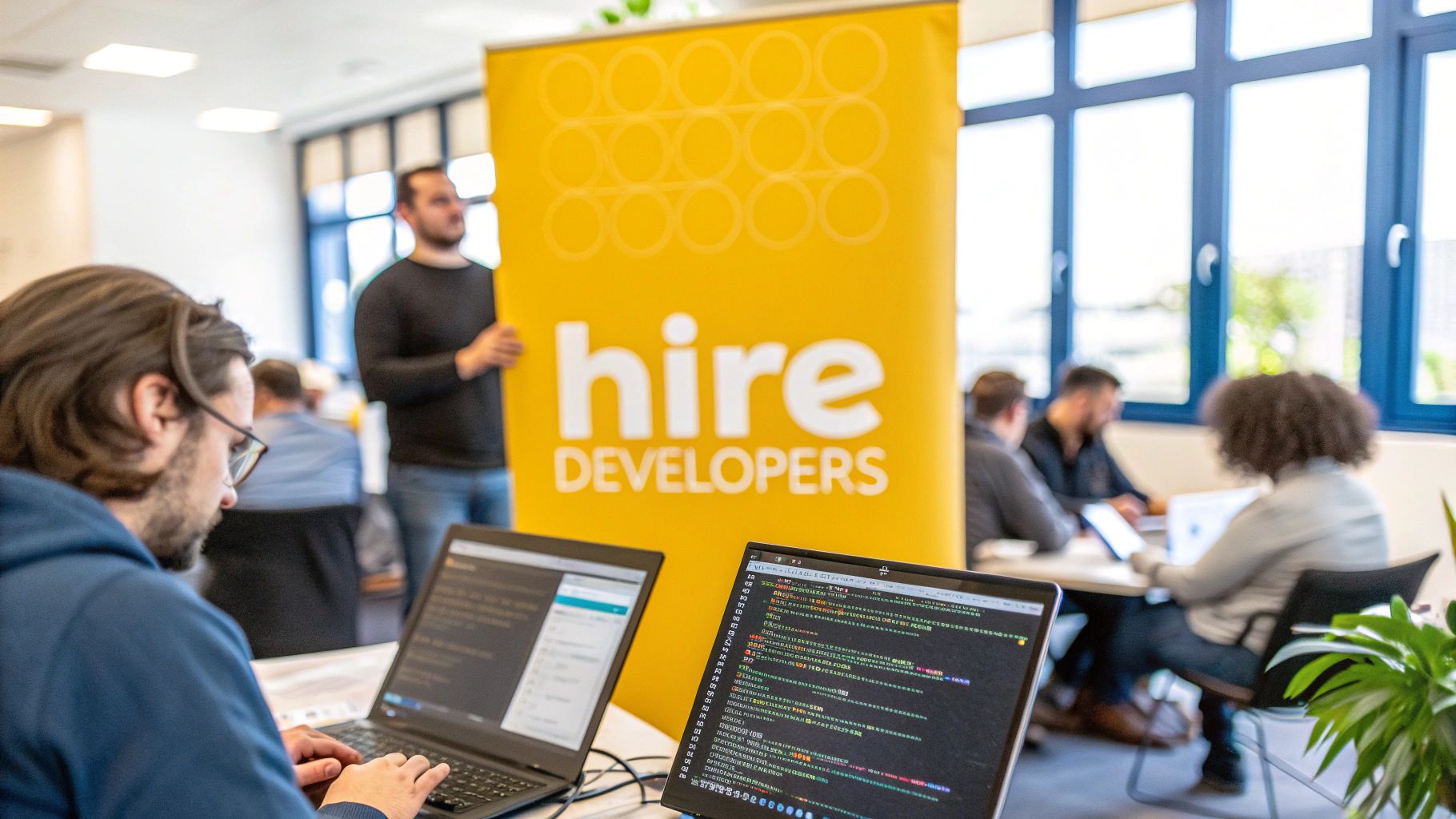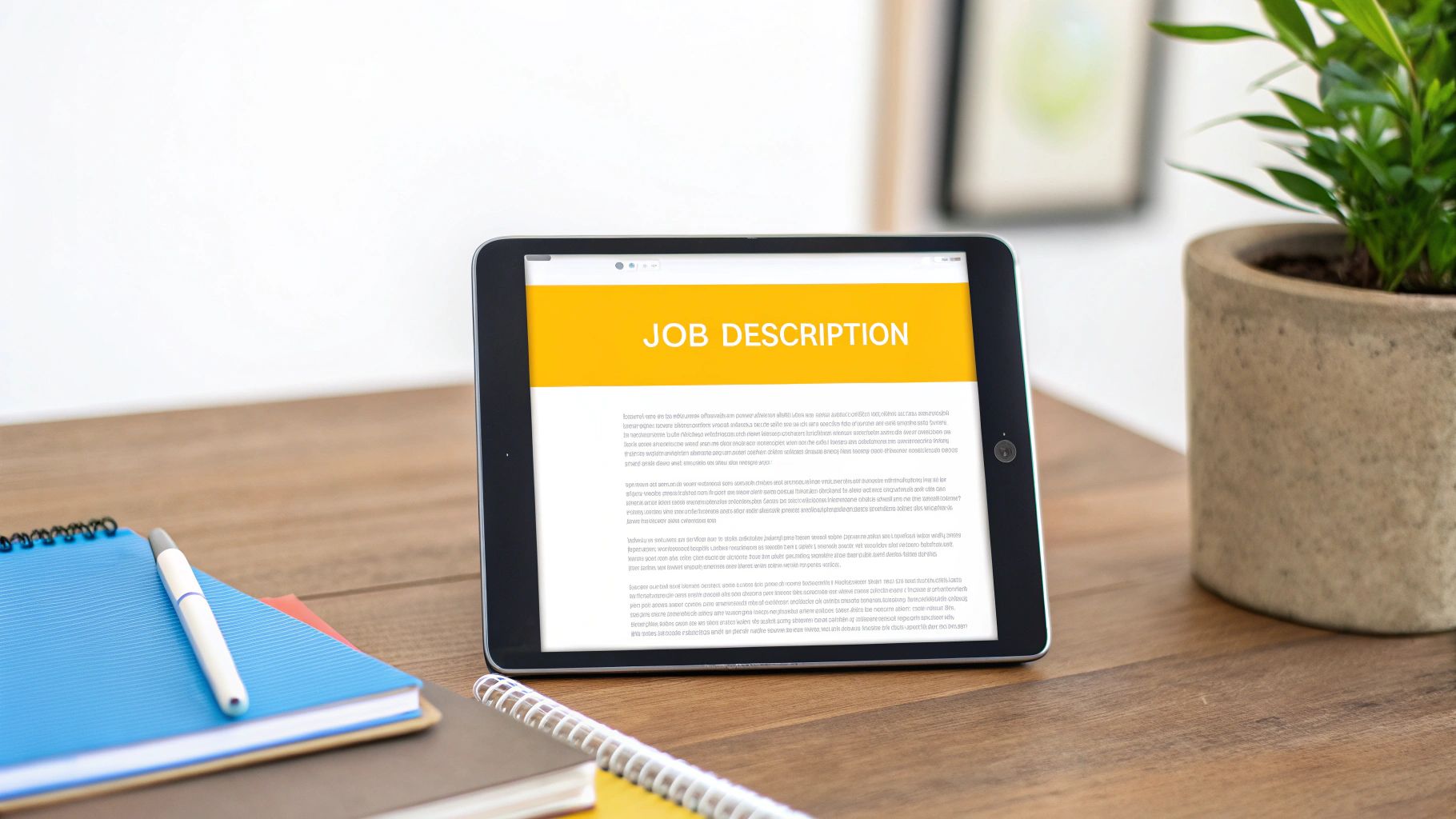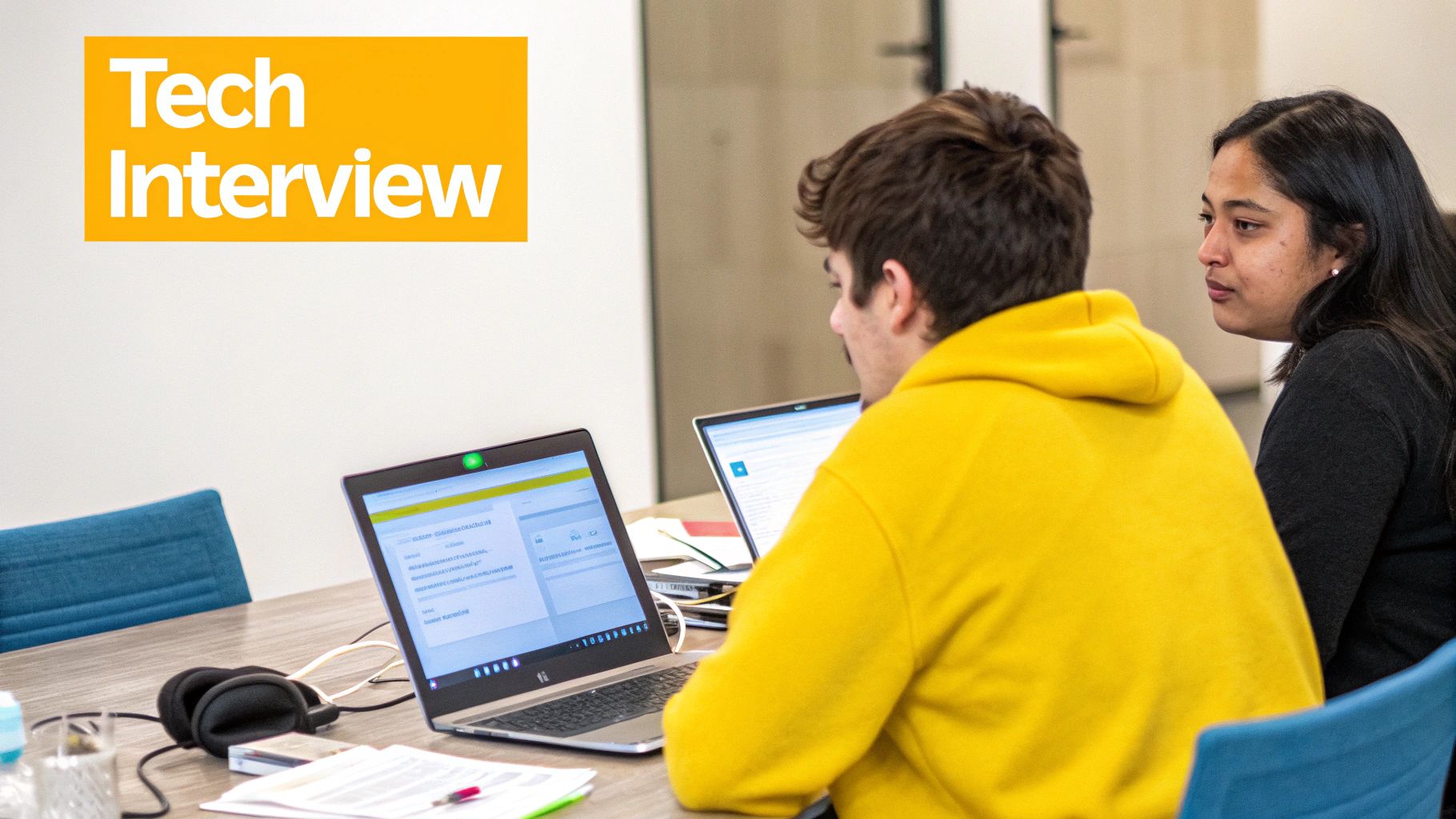Hiring Developers For Startup Success

Before you even think about posting a job ad, let's talk about the single most important step in hiring a developer: defining the role. I know the pressure is on to build, and it’s tempting to just jump in and start interviewing. But trust me, rushing this part is the number one reason startups make a bad hire.
Getting this foundation right isn't just a preliminary task; it's everything. It will save you from costly mistakes and set your future technical team up for success from day one.
Laying the Groundwork Before You Hire
Think of it this way: you wouldn't start building a house without a solid blueprint. Hiring your first developer is no different. You need a detailed plan that outlines not just what they’ll build, but exactly how their skills will push your immediate business goals forward. This initial planning directly shapes your budget, your product timeline, and the very culture of your company.
Generalist vs. Specialist: The First Big Decision
One of the first forks in the road is deciding between a generalist and a specialist. Your startup's current stage and what you need to achieve in the next six months will make this decision for you. The difference is huge, and getting it wrong can bring your progress to a screeching halt.
The Generalist (Your "Swiss Army Knife"): This is your go-to for most pre-seed or seed-stage startups. A generalist is a versatile problem-solver who can comfortably jump across the entire tech stack, from tweaking the database to polishing the user interface. They excel when things are a bit chaotic and are perfect for building your Minimum Viable Product (MVP) from the ground up.
The Specialist (Your "Scalpel"): You bring in a specialist when you have product-market fit and need to double down on a specific feature. This might be an iOS developer to launch your mobile app, a data scientist to build a personalization engine, or a DevOps expert to scale your infrastructure.
For most founders just starting out, a generalist is the safer and more strategic bet. Their broad skill set is an asset when your product inevitably pivots and evolves. You're hiring for adaptability, not just a narrow list of technical skills.
Aligning Technical Needs with Your Business Goals
If you're a non-technical founder, this is where you can easily get tripped up. It’s common to make vague requests like, "I need someone to build my app." You have to get more specific by framing your needs around what your users will do.
Key Insight for Non-Technical Founders: You don't need to know how to code, but you must be crystal clear on what you want the code to achieve. Focus on user actions and business outcomes. A good developer can then translate that vision into a tech stack.
For example, instead of saying you need a "React developer," describe the actual goal: "We need to build a web dashboard where users can sign up, create a profile, and upload photos." This outcome-first approach empowers a technical advisor or a candidate to suggest the right tools for the job. It also shifts your focus from hiring a code-writer to hiring a true problem-solver.
Creating Your Developer Value Proposition
Now for the final piece of the puzzle. Early-stage startups rarely win on salary alone; you can't compete with the paychecks from Google or Meta. Your offer has to be about something more compelling: the opportunity.
You're selling a vision. Your value proposition should be built around these pillars:
- Meaningful Equity: Don't just mention it; frame it as a true partnership in the company's future. They are a co-builder, not just an employee.
- Direct Impact: Make it clear their work will be the core of the product. They won't be a tiny cog in a massive machine; they are the machine.
- Autonomy and Ownership: For the right person, the chance to shape the tech stack, the product direction, and the engineering culture from scratch is an incredible draw. This is what attracts entrepreneurial engineers.
Writing a Job Description That Attracts Top Engineers

Let's be honest: your job description is your most critical sales pitch when you’re trying to hire developers for a startup. It’s the very first impression you make, and if it reads like a generic, corporate-speak template, you've already lost the kind of engineers you want to attract.
Think of it less as a list of demands and more as an invitation to join a mission. This is your chance to stand out. Start by leading with your why, not with a laundry list of programming languages. What massive problem are you trying to solve? Why should a brilliant developer pour their energy into your vision instead of the countless others clamoring for their attention? You have to hook them with the purpose behind the code.
Sell the Challenge, Not Just the Role
I've seen it a hundred times. Startups post a job, and it’s just a list of duties. Top engineers aren't motivated by duties; they're driven by complex challenges and the chance to make a real impact. Your job description has to spell out the specific, meaty problems they’ll get to sink their teeth into.
Let's compare.
The Generic Duty: "Write and maintain clean, efficient code for our platform."
The Compelling Challenge: "Architect and build our real-time data processing pipeline from the ground up, tackling latency issues to deliver instant insights to thousands of users."
See the difference? The second one is a puzzle waiting to be solved. It speaks directly to a developer's desire to build something meaningful and technically impressive. This approach naturally filters for candidates who thrive on ownership and a steep learning curve—exactly the people you need on an early-stage team.
Differentiate Must-Haves from Nice-to-Haves
One of the most common pitfalls is creating a scary "wish list" of every technology under the sun. This intimidates great candidates who are incredible problem-solvers but don't happen to check every single box. A much better approach is to split your requirements clearly.
- Must-Haves: These are your absolute non-negotiables. Keep this list short and focused—think 2-4 core skills that are truly essential for the job (e.g., deep experience with Node.js, proficiency with relational databases).
- Nice-to-Haves: This is where you can list bonus skills that would be helpful but aren't deal-breakers. Things like familiarity with GraphQL, experience with AWS Lambda, or even a good sense of humor can go here.
This structure tells candidates you’re realistic and that you're hiring a human being, not just a walking tech stack. It opens the door to a much wider pool of talent.
A Quick Word on the Market: It's crucial to be strategic here. While great talent is always in demand, the market has cooled off. Software developer job postings have dropped by about 34-35% recently, making the entire field more selective. This means a thoughtfully crafted, compelling job description is more critical than ever to get noticed by the best engineers out there. You can dig into more of this data by checking out the software engineering job market trends at The Pragmatic Engineer.
Be Upfront About Compensation and Benefits
Finally, don’t play games with compensation. Including a salary range right in the job description builds trust from day one and shows you respect the candidate's time.
In a startup, equity is a huge part of the equation. Briefly explain your equity offering and frame it for what it is: a real stake in the company's future success. Tying it all together by clearly listing your benefits—from health insurance to your remote work policy—shows you genuinely care about your team's well-being. This kind of transparency sets a positive, professional tone for the entire hiring process.
Finding and Sourcing Your Ideal Candidates

Alright, you've got a compelling job description. Now comes the real work: getting it in front of the right people. Let's be honest, the top-tier developers you actually want to hire aren't spending their days scrolling through massive, generic job boards. Hiring developers for a startup is less about posting an ad and more about executing a surgical sourcing mission.
This means you have to go where developers actually live and breathe—the online communities where they collaborate, learn, and share their work. Forget waiting for candidates to come to you; you need to actively hunt for them in their natural habitats.
Go Beyond the Usual Job Boards
Sure, posting on LinkedIn or Indeed is a decent starting point, but it's a passive approach that casts an incredibly wide and unfocused net. The startups that consistently win the talent war are the ones engaging with niche communities where skilled developers put their expertise on display every single day.
Think of these as your prime hunting grounds:
- GitHub: This is so much more than a code repository; it's a living, breathing portfolio. I always look for developers contributing to open-source projects relevant to our tech stack. An active GitHub profile is one of the strongest signals of genuine passion and proven skill.
- Stack Overflow: Don't just post jobs here. Pay close attention to the users who provide incredibly thoughtful, high-quality answers to complex technical problems. Their ability to break down and articulate solutions is a huge indicator of deep understanding and strong communication skills.
- Specialized Developer Forums & Slacks: Whether it’s a community for React Native, Python, or Web3, these forums are absolute goldmines. The key is to participate authentically. Build relationships first, then you can start to identify potential fits for your team.
The goal here is a fundamental shift in mindset: move from "posting a job" to "starting a conversation." This proactive outreach is what will set your hiring process apart.
The Art of Personalized Outreach
Once you’ve spotted a promising candidate, firing off a generic, copy-pasted message is a guaranteed way to get ignored. Developers with in-demand skills are bombarded with dozens of these lazy messages every week. Your outreach has to cut through the noise by showing you’ve actually done your homework.
A cold message that actually gets a response needs to do three things well:
- Reference Their Specific Work: Kick things off by mentioning something specific you admired. For example, "I was really impressed by your contribution to the [Project Name] library on GitHub," or "Your answer on Stack Overflow about [Technical Topic] was incredibly insightful."
- Connect It to Your Challenge: Briefly explain the interesting problem your startup is tackling and, crucially, why their specific skills make them a good fit to help solve it.
- Make a Clear, Low-Friction Ask: This is key. Don't ask for a resume or a formal interview right away. Instead, go for something much simpler, like a brief, informal 15-minute chat to share more about the challenge.
This approach shows you have genuine interest and respect their expertise, which dramatically increases your chances of getting a reply.
Exploring Your Sourcing Options
The global tech talent shortage isn't just a headline; it's a very real problem for startups. In the U.S. market alone, projections show a potential shortfall of around 4 million programmers by 2025. This makes it absolutely critical to think beyond the traditional in-house employee. This detailed guide to hiring startup developers explores this challenge in more depth.
My Takeaway: Startups need developers who are autonomous, resourceful, and can wear multiple hats. This inherently narrows the candidate pool, making it vital to consider all available talent models if you want to maintain a competitive edge.
Let's look at the different channels you can use to find talent. Each has its place, and knowing when to use which is a huge advantage.
Developer Sourcing Channel Comparison
| Sourcing Channel | Best For | Pros | Cons |
|---|---|---|---|
| In-House Hires | Building your core, long-term team and defining your company culture. | Deep product knowledge, high commitment, strong cultural integration. | Expensive, slow to hire, limited to your local talent pool. |
| Freelancers | Short-term, well-defined projects like building an MVP or a specific feature. | Fast to onboard, cost-effective for specific tasks, high flexibility. | Lacks long-term investment, less integrated into the team, knowledge can walk away. |
| Nearshore Partners | Scaling your team cost-effectively with skilled, culturally aligned talent. | Access to a wide talent pool, significant cost savings, minimal time-zone issues. | Requires excellent communication and processes, potential for cultural nuances. |
As you can see, there's no single "best" answer. For many startups I've worked with, a nearshore model offers a powerful middle ground. It lets you tap into a much broader talent pool in nearby countries, giving you a cost-effective way to scale your development team without the frustrating communication delays of traditional offshoring.
If you go this route, make sure you thoroughly vet any potential nearshore partner. Zero in on their communication processes and their track record of successfully integrating with other startups. Get this right, and it can be a total game-changer for accelerating your product roadmap without burning through your cash.
Running an Interview Process That Reveals True Skill and Fit

Let's be honest: your interview process is more than just a technical exam. It's a two-way street. While you're trying to figure out if a candidate has the chops, they're deciding if your startup is a place they actually want to be. A clunky, disorganized, or disrespectful process will send top talent running for the hills.
The goal isn't to stump engineers with gotcha questions or obscure whiteboard puzzles. It's to create a structured funnel that gives you a real sense of how they think, solve problems, and collaborate. A multi-stage process helps you build a complete picture of each person, moving far beyond what a resume can tell you.
The Initial Screening Call
The first conversation, usually a quick 30-minute chat, sets the stage for everything. This isn't the time for a technical deep-dive. It's a gut check to see if there's a mutual interest and if the basics align.
I use this call to get a few key things straight right away:
- Real Interest: I ask what specifically about our mission or product made them apply. A vague, canned answer is a pretty clear red flag.
- The Practical Stuff: This is where you talk salary expectations and availability. Getting this sorted out early saves everyone a massive amount of time.
- A Quick Project Tour: I have them walk me through one or two past projects they’re particularly proud of. I’m listening for their specific contributions and the impact their work had.
This initial screen is your most effective filter. It lets you quickly weed out candidates who are a mismatch on the big things, so you can focus your energy on the ones who really show promise.
The Take-Home Coding Challenge
A take-home challenge is probably your best window into a developer's actual work. It gets them out of the high-pressure hot seat of live coding and lets them work in their own environment. It shows you how they build a small, functional piece of software from the ground up.
A good take-home assignment is tightly scoped, clearly defined, and directly related to the kind of work they'll be doing every day. Crucially, it must respect their time—aim for something that takes no more than 3-4 hours. Anything more is a fast way to alienate great candidates who already have a full-time job.
For a frontend developer role, for instance, you could ask them to build a simple single-page app that pulls data from a public API and displays it with some basic interactivity. This tests their real-world ability to handle asynchronous data, manage application state, and build a clean UI.
The Technical Deep Dive
Once their take-home is submitted, the next step is a collaborative review, not an interrogation. This is where you sit down with them—virtually or in person—and actually talk through the code they wrote.
I always start by asking them to walk me through their solution. This tells you a ton about their communication skills and thought process. From there, you can dig deeper with follow-up questions.
- "Talk me through the trade-offs you considered for this architectural choice."
- "If we needed to add [X feature] to this, how would you go about it?"
- "What would you do differently if you had another week on this?"
These kinds of questions mimic the daily conversations you'd have on a real team and reveal how they think about scalability, maintenance, and constructive feedback.
The Final Culture and Vision Interview
The final interview is all about determining if they'll genuinely thrive in your startup’s unique environment. This isn't about the "beer test." It's about making sure you align on work ethic, communication styles, and a shared passion for what you're trying to build.
This becomes more critical as you grow. Hiring data shows a dramatic escalation in the need for developers as companies secure more funding. IPO-stage startups posted around 435,943 job openings between February and April 2025, a massive leap from the 153,412 at Series A. Your process has to find people who can scale with you. For a closer look at this data, check out the startup hiring trends at Jobright.ai.
To get at this, ask behavioral questions that draw on past experience:
- "Tell me about a time you had a strong disagreement with a colleague. How did you work through it?"
- "Describe a project that failed. What was your biggest takeaway from that experience?"
- "What kind of environment do you need to do your absolute best work?"
Their answers give you a much clearer picture of their self-awareness, resilience, and collaborative spirit—all non-negotiable traits for any developer on a small, fast-moving team.
Closing the Deal: The Offer and Onboarding Your New Hire

You’ve navigated the technical deep dives and cultural interviews, and you’ve found the one. It's a great feeling, but the race isn’t over. Honestly, this final lap is where so many startups stumble. Successfully hiring developers for a startup isn't just about finding talent; it's about closing the deal swiftly and setting them up for a long, successful run with your company.
The time between your decision to hire and their first day is a high-risk zone. The best engineers almost always have multiple offers on the table. In this scenario, speed is your greatest weapon.
Don't Wait: Crafting and Delivering a Compelling Offer
Your verbal offer should land within 24 hours of making the final decision. Don't leave a great candidate hanging, wondering where they stand. Follow that up with a formal, written offer letter within another day. This document needs to be crystal clear and professional, leaving absolutely no room for confusion.
Think of the offer letter as more than just numbers; it's the final sales pitch, a tangible reminder of the vision you sold them on. Make sure it clearly spells out:
- Cash Compensation: The base salary, whether annual or monthly.
- Equity Grant: The total number of stock options, the vesting schedule (a four-year schedule with a one-year cliff is standard), and the strike price. I always frame this as their personal stake in our shared success.
- Key Benefits: Health insurance, paid time off, and any unique perks you offer, like a remote work stipend or a professional development budget.
- Start Date: The proposed first day of work.
When it comes to negotiations, be prepared, but don’t make it a battle. A great hire is a partnership, not just a transaction. If they counter, take a breath and listen to understand why. Is it really about the base salary, or do they value a larger piece of the equity pie? Be flexible where you can, but also be transparent about your startup’s very real constraints.
Pro Tip from the Trenches: Time kills all deals. If you take a week to pull an offer together, your top candidate has likely already said "yes" to someone else. Have an offer letter template ready and your decision-makers aligned so you can move with purpose.
The First 90 Days: An Onboarding Plan That Actually Works
So, they accepted your offer—fantastic! Now the real work begins. A new hire's first few months are absolutely critical. A solid onboarding process dramatically improves retention and gets them contributing meaningfully, fast. A weak one just leads to frustration, confusion, and sometimes, a quick exit.
Onboarding isn't just about handing over a laptop and a Slack login. For a startup, it's about deep integration into your mission, your culture, and your codebase. Your 90-day plan needs to be deliberate and structured.
The First Week: Getting Grounded
The first week is all about connection and orientation, not shipping a major feature. The goal is simple: make them feel welcome and prepared.
- Day 1: Make it all about people and culture. Schedule one-on-one chats with every single person on the team, not just the other engineers. As a founder, I make sure to spend at least an hour with them, personally reiterating the company’s vision and why their role matters.
- Days 2-3: Time for tools and processes. Get their dev environment set up, sure, but also walk them through your project management flow (Jira, Linear, etc.), your communication norms, and the deployment pipeline. Assign them an "onboarding buddy"—another engineer who can be their go-to for all the small questions they might feel shy about asking.
- Days 4-5: Let's look at some code. Give them their first small, low-risk bug fix to tackle. The goal here is a quick win. It gets them familiar with the entire process, from creating a pull request to seeing their code go live.
The First Month: Building Momentum
During the first 30 days, we shift from orientation to active contribution. They should be taking on small- to medium-sized tasks and gaining confidence in their ability to work within your product and systems.
Set a clear, achievable goal for their first month. This could be something like shipping one minor feature or resolving a specific list of bugs. It gives them a target to aim for and a real sense of accomplishment when they hit it. Schedule weekly check-ins to give feedback, answer their questions, and make sure they feel supported, not abandoned.
This kind of structured approach can transform what might be an overwhelming experience into a motivating journey. It solidifies their decision to join your team and lays the foundation for a long, productive partnership.
Common Questions About Hiring Startup Developers
Hiring your first developers is one of the most nerve-wracking parts of building a startup. As a founder, you're bound to have a ton of questions swirling around—from figuring out equity splits to trying to spot red flags in an interview. Let's dig into some of the most common questions I hear and give you some straight, practical answers to help you build your technical team the right way.
How Much Equity Should I Offer My First Developer Hire?
Offering equity isn't just a sweet-sounding perk; for most early-stage startups, it’s the only way to attract top-tier talent. The right amount tells a potential hire that you see them as a true partner, not just an employee, and it's essential for getting someone who’s genuinely invested in your vision.
So, what's the magic number? It really depends on the developer’s experience and where you are in your funding journey. For a pre-seed or seed-stage company, a first non-founder engineer typically gets between 0.5% and 2% equity. This is almost always granted on a four-year vesting schedule with a one-year cliff, which is standard practice. It means they need to stick around for at least a year to start getting any of their shares.
If you’re hiring a more senior or lead developer who’s going to own your entire tech strategy, you can expect to offer something on the higher end of that range, or maybe even a little more. The trick is to find that sweet spot between a competitive equity stake and a salary you can actually afford.
Key Takeaway: Don't just present equity as a number. Frame it as a partnership. You're not just giving away a piece of the pie; you're inviting them to help you bake a much bigger one. And always, always get a lawyer or a seasoned startup advisor to help you structure the grant correctly.
What Are the Biggest Red Flags to Watch For in Interviews?
Beyond someone just not having the technical chops, there are more subtle red flags that can signal a candidate will be a bad fit for the chaos and intensity of a startup. You have to look for clues that go deeper than just their coding ability.
- Zero Curiosity: This is a big one. If a candidate isn’t asking you thoughtful questions about your product, your customers, or your mission, it's a major warning sign. Great startup developers are problem-solvers at heart; they want to build something meaningful, not just punch a clock.
- Awful Communication: A total dealbreaker. Pay close attention to how they walk you through their thought process during a technical challenge. If they can’t clearly explain why they're doing what they're doing, they'll be a nightmare to collaborate with.
- The Blame Game: Be wary of anyone who only has negative things to say about every past employer. One bad experience is understandable, but a clear pattern suggests they might struggle to take ownership or work well with others.
- All About the Perks: If their first questions are about free snacks and vacation days before they’ve even asked about the core challenges of the role, their priorities might not line up with the gritty, all-hands-on-deck reality of an early-stage company.
Should I Hire a Freelancer or a Full-Time Employee?
This is a classic startup crossroads, and the right answer really hinges on what you need right now versus what you need long-term. Neither is inherently better—they just solve different problems.
A freelancer is your go-to for short-term, clearly defined projects. Think of things like building a specific feature, knocking out a landing page, or getting a quick-and-dirty MVP built to test an idea. Hiring a freelancer is faster and usually cheaper upfront, giving you speed and flexibility without a long-term commitment.
But for your core product—the heart of your company—a full-time employee is almost always the smarter long-term bet. They become deeply invested in the company's success, help shape your culture, and build up priceless institutional knowledge about your codebase and your users. That's a level of commitment a temporary contractor just can't match.
How Can a Non-Technical Founder Effectively Hire a Developer?
This is a huge source of anxiety for many founders, but it's completely possible to get it right. You don't need to know how to code, but you do need to be an expert on your vision and a sharp judge of character.
First, get technical backup. This could be a mentor, a friend who's an engineer, or even a paid consultant from a firm like Nerdify. Their job is to help you define what you actually need from a technical standpoint and, crucially, to vet a candidate’s skills during the interview.
Second, lean into what you can evaluate: their problem-solving approach, their communication style, and their passion for what you're building. Ask candidates to explain a complex technical idea in simple terms. A great developer can bridge that gap and make you feel understood.
Finally, a paid "work trial" is one of the best tools in your arsenal. Give your top candidate a small, self-contained project as a final interview step. It’s the most direct way to see their code quality and how they operate, taking a lot of the guesswork out of the equation. Look for the person who gets genuinely excited about the idea of owning the technical roadmap—that self-starter energy will be your greatest asset.